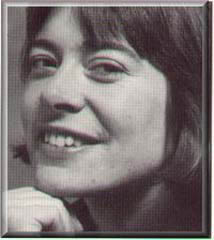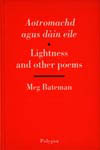Meg Bateman
Lightness in the Highlands
 There is much in Meg Bateman’s present lifestyle that seems like the culmination of all that has gone before, not only in its rejections and refusals, but also in its achievements and redemptions. She teaches at the Gaelic College at Ostaig on the Sleat peninsula in Skye, living just a few miles of twisty single-track to the north in a sparse coastal village that carries a Norse name meaning Cod Bay. On a good day the view from her window takes in Rum, Eigg, Canna and the Outer Isles. Not on the day I visited, however, when the mist was down to the shore and torrential rain had all the rivers up and sometimes across the road.
There is much in Meg Bateman’s present lifestyle that seems like the culmination of all that has gone before, not only in its rejections and refusals, but also in its achievements and redemptions. She teaches at the Gaelic College at Ostaig on the Sleat peninsula in Skye, living just a few miles of twisty single-track to the north in a sparse coastal village that carries a Norse name meaning Cod Bay. On a good day the view from her window takes in Rum, Eigg, Canna and the Outer Isles. Not on the day I visited, however, when the mist was down to the shore and torrential rain had all the rivers up and sometimes across the road.
Meg’s son met me at the door, introducing himself as Colm, aged six. When I told him I was Bob, aged fifty, the phone went down and a female voice announced she was Meg, aged forty. After this exchange of facts we two adults continued our conversation in the kitchen while Colm divided his time between a video and us.
Born of English parents in Scotland, Meg Bateman began her life in Milton Mill, near Edinburgh, before the family of three daughters and a son moved to Ainslie Place in the New Town. Despite being educated at Mary Erskine’s, a grant aided school, she still firmly holds to the mindset she adopted then – against privilege in education.
It was during those formative years that the major key of her life presented itself. She remembers attending a concert of Gaelic song, and being ‘utterly amazed’ by what she identified as the possibility of a different kind of community presented through the sublime beauty of the music. She began to learn the language.
After completing her time at school she went to university in Bristol, eventually taking a degree in Celtic Studies at Aberdeen. There was a tradition of academic excellence in the family – her parents had met doing their PhDs in genetics. When Meg took her own doctorate in Medieval Religious Poetry in Gaelic another keynote sounded in her life and she began a twenty year journey that led, last Easter, to her formally joining the Catholic church.
Religion, she told me, is now ‘the most important thing’. At one time she had been very attracted to the Quaker tradition, its absence of professional clergy and church property, its determined egalitarianism, its meditative silences. A move in that direction would have been easy for her to make. Often, though, she does the thing that is most difficult. Despite her recent entry into the Catholic church, she remains critical of Cardinal Winning’s position on Clause 28, believing it devalues the humanity of homosexual people, comparing that to racism. Her father, an outspokenly atheist, could not accept an approach to life and the living of it that was not fact-based. By contrast, Meg sees her religion as a complementary approach to existence, ‘man-made – our chance to encapsulate what is most human about humanity.’ With her hands she indicated what she described as the ‘horizontal dimension of Catholicism, rather than the vertical dimension of Protestantism’. She feels that all her poems, perhaps all poems worth the name, have their spiritual element.
Ideology has no place in her art. She is convinced that writing to a political or activist agenda does not work poetically. This includes feminism, Marxism, fascism, all the ‘isms’. (She agrees with me that when Hugh MacDiarmid turned to revolutionary idealism his ‘bonny sangs’ began to go off tune.) Meg Bateman’s poetry is a formidable mix of heart and head.
As we spoke, Colm reappeared from his secret place in the living room and made some slight demand for attention. Meg took him to her, and as she whispered in his ear her diction strayed between Gaelic and English. Satisfied that all was well, he arranged a series of cups and containers along the table and set about filling one and then another with soapy water. It seemed to me then that the creative duality in Meg Bateman’s spiritual make-up had been made manifest. Our topics had been serious, by any standard, yet she had punctuated her observations with laughter and her smile was never absent for long. We turned again to the poetry.
Meg Bateman’s first, full-length collection of poems, written in Gaelic and Irish, Orain Ghaoil, was published by Coiscéim, Dublin, in 1990. Her first collection with English translations, Aotromachd/Lightness, was shortlisted for the 1997 Stakis Prize. It contains forty-seven Gaelic poems with English language versions presented on facing pages – giving Gaelic primacy since it is the language in which they were conceived.
For a while we talked about my favourite, the love poem ‘O Bonnie Man, Lovely Man’. Unknown to me then, it is based on the tune of Bothan Airigh am Braigh Rainnich. This poem is arranged in couplets of six or seven syllables with rhymes traditionally laid on the last stress of the first line and within the second line. Its closing line tells us, ‘you’ve brought a song to my lips’, and when she sang it to me it became apparent that music is inherent in her poetry. She has a mellifluous alto that brings out the music as much in the reading of her work as in the singing.
In addition to their femininity, what is most often noted in Meg Bateman’s poems is their feeling of accuracy, achieved through a diction almost bereft of adverbs and adjectives (as in some Gaelic songs). When adjectives do appear, they come loaded with additional significance.
Her most requested, and most published poem, is ‘Lightness’, a love poem of eight lines presented as a single verse. The poet addresses someone she has been drawn to by his ‘lightness’. She lists the way it has manifested itself: his talk, his laughter, his cheek in her hands. She repeats the word for emphasis, this time vesting it with no fewer than three adjectives – sweet, gentle, modest – this quality of lightness is one she strains to capture. Then come the absences: the lightness of the kiss, the lightness of the embrace.
The collection as a whole is presented in the same steady voice of appraisal and acceptance. It begins with an old man’s illness, ‘looking out from sorrow/my father’s great eyes’, and presents both lived and observed experience in precise vignettes. The steadiness of observation disallows mitigation but preserves hope. Alcoholism in the family, the decline of Gaelic, war, the memory of her mother, all are faced. There is a six-poem sequence of aching vulnerability, ‘To a Married Man’. Through the book there is the growing presence in the poetry of the child.
It has been suggested that there is a good deal of irony in Meg Bateman’s work, but to me the enduring feel of this book is one of concision and intimacy. The book closes on ‘The Burial of Sorley MacLean’, and on hope for the future of the Gaelic language. ‘In May/your mirth will rise in the sappiness’.
A note that the poems are arranged in order of writing seems to invite a reading as biographical narrative. If so, the story continues in the twenty-two poems, ‘Recent Poems 1997-1999′, in Etruscan Books IX.. This collection begins with ‘Flitting’, a poem of letting go, contrasting with her son’s reaching out. I was struck by the pessimism and disillusion in these poems: as in ‘Gaelic Concert’ on an uninspired rendition of the songs she loves, as in ‘Broken Egg’ and her son coming to understand that ‘beauty does not last’. In ‘Teacher’ she writes, ‘I am left suddenly/uncertain/of the steps’, with that word, ‘uncertain’, significantly carrying a line of its own. This collection is similar in its techniques to Lightness, but with the altered standpoint that might be expected over a period of fifteen years.
I asked her why she writes. She told me that emotion starts her off. She wants to put something ‘in place’. When she writes a poem she wants to make ‘a thing’, that is the work. And how she writes? Very few poems are finished at a sitting, and each sitting can take several hours with most of the time spent removing words, effecting alterations that are often, apparently, minute. The poems she sees as ‘emotional and intellectual signposts’. She no longer sees the world as regulated enough to allow regular rhyme schemes.
Meg Bateman is a teacher to her core. She instructs, she leads, she encourages. She lets go. Her son will have the language, but will be free to live in the world as he finds it. For seven-and-a-half years she taught Celtic Studies at Aberdeen university, and now for over a year has taught at Sabhal M
òr Ostaig. She has a sense of mission in the survival and recovery of the Gaelic language, but is in no doubt that its future is far from assured.
Her contribution to Scottish letters has been considerable. For three years she was Gaelic advisor to New Writing Scotland, has judged numerous literary competitions and now serves on the Scottish Arts Council book awards panel. She co-edited the anthology, The Harps’ Cry, and is a translator of note. Translation, it seems, is what she does to relax, describing it as being mechanical, ‘like knitting’. With that, she made a tying and casting off gesture with her hands.
 Later, driving along the coast in the pouring rain, it was her poems that were in my mind, their steadiness of vision, their rejection of compromise. Searching for a metaphor I noted the bay to my left, the clarity and force of the waves coming in, their breaking on the immovable rocks.
Later, driving along the coast in the pouring rain, it was her poems that were in my mind, their steadiness of vision, their rejection of compromise. Searching for a metaphor I noted the bay to my left, the clarity and force of the waves coming in, their breaking on the immovable rocks.
Aotromachd/Lightness was short-listed for the 1997 Stakis Prize. It is published by Polygon, PBK £6.99, ISBN 048662278.
Copyright Robert Davidson 2005.

Comments